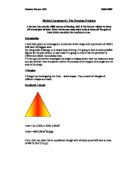Maths Coursework
The Fencing Problem
Anthony Lynch
Introduction
This coursework is a problem involving a farmer. She has 1000 metres of fencing and is looking to create a fenced off area that is as large as possible. She wants to know what shape to arrange the fencing in order to achieve this.
I hope to find out which shape would be most appropriate for this use. I will investigate the different formulas and areas of different shapes and compare results to come to a final conclusion.
The Quadrilaterals
The Square
The only square with a perimeter of 1000 meters, has four sides each being 250 metres in length.
Following the formula area = length x width, the area works out to be 62500 m².
Conclusion
As there is only one square, there is only one area that can be obtained, it is 62500 m².
The Rectangle
The rectangle is much more complicated, as there are many combinations in length and with that amount to many different areas.
The Kite
The kite is very similar to the rectangle in the way that the results depend upon two sides (in this case vertices) that total 500.
The Parallelogram
I knew that the side length that produces the largest area would be 250 by 250. The area of a parallelogram is the base x vertical height. The vertical height can be worked out using ‘side length sin θ’.

I realised that the maximum value of θ was 90. When I worked out 250 sin θ,
I found that it produced the result 250. This therefore produced a square.
Conclusion
I found that again, the largest area produced was 62500m². This is the same as the parallelogram, the rectangle, the kite and especially the square.
The Rhombus
The ...
This is a preview of the whole essay
I realised that the maximum value of θ was 90. When I worked out 250 sin θ,
I found that it produced the result 250. This therefore produced a square.
Conclusion
I found that again, the largest area produced was 62500m². This is the same as the parallelogram, the rectangle, the kite and especially the square.
The Rhombus
The rhombus, like all quadrilaterals must have fours sides, these must all be equal. Therefore there can only be one value for any side, 250.
Conclusion
Although the angles of a rhombus can differ, I knew that regular shapes have larger areas. So, in this case 250 x 250 and angles of 90° form the largest possible area. Again, like the square, they produce an area of 62500m².
The Trapezium
The trapezium can be worked out in almost the same way the same way as the parallelogram using the ‘vertical height = side sin 90’ formula. Using the area formula ‘ area = ½ x (a + b) x h’ I realised that, as in the parallelogram, the largest value of sin could be 90. Thus creating the largest area, and transforming the trapezium into a square.
Conclusion
I found the area to be exactly the same as all of the other quadrilateral, and so, exactly the same as a square, having the maximum area of 62500m².
The Quadrilaterals
The Conclusion
I have found that all of the quadrilaterals are connected to the area formula of a square. Because of this, they all have a maximum area of 62500m². This is achieved in most cases using the formula,
Area = 250m x 250m
The Triangles
The Equilateral Triangle
The equilateral triangle is the almost ‘the square’ of the triangles in that all of the sides have to be the same length, and the angles must all be equal. As with the square, there is only one equatorial triangle with the perimeter of 1000m.
Using the formula ‘½ ab sin c’, I was able to work out the total area.
½ x 333.3334 x 333.3334 x sin 60 = 48112.715 m²
Conclusion
I found that the largest area of an equilateral triangle with a perimeter of 1000m was 48112.71 m².
The Right angle Triangles
There are three ratios that a right angle triangle must fit. I worked each of the areas out and calculated the largest of the three areas.
A = ½ b x h
Conclusion
I have looked at three possible ratios and therefore thee possible areas, as there is a limited perimeter of 1000m. By fat the largest area was 41645.5m², this was from the ratio 3:4:5.
The Isosceles Triangle
For the values of the sides, I worked out the maximum they could be while fitting the triangle isosceles. I found that A could be 345 m
B could be 345 m
C could be 330 m
By using the formula ‘cos θ = 165/345’, I was able to find that the bottom left and right angles were 61°. Using this I was able to the use the formula ‘½ base x tan θ’ to work out the perpendicular height of my triangle.
½ base x tan θ = ½ x 330 tan 61 = 297.66 m
A = ½ b x h
Conclusion
Using the formula ‘A = ½ b x h’ and the formula for perpendicular height
‘h = 1/2 base tan θ’, I was able to find that the largest area for an Isosceles triangle, with a perimeter of 1000m is 44550m². The shape cannot be completely equal to the quadrilateral triangle, as an Isosceles triangle must have two equal sides and one different side.
The Scalene Triangle
_______________
The scalene triangle has the formula √ S (s-a) (s-b) (s-c)
Where S = a + b + c
2
While working with the above formula, I realised that the scalene triangle with the largest area was the same as the equilateral triangle.
Conclusion
In a way, this is a similar scenario as with the kite and the rhombus. Although the formula is different, the largest version (in terms of the area) of the shape is exactly the same as the simplest, like the square, or in this case the equilateral triangle.
The Triangles
The Conclusion
As with the quadrilaterals, I have found that the most regular shape, in this case the equilateral, has the largest area. I also found that all of the triangles relate strongly to the equilateral. In conclusion, the largest area that can be formed from a triangle with a perimeter of 1000m is 48112.715m².
The Polygons
The Pentagon
The pentagon is completely new kind of shape, despite the fact that it only has one more side than the quadrilateral shapes.
I started by dividing 360° by the number of sides, in this case 5.
This gave me 72°, which is the exterior angle. As the triangles that make up the polygons are isosceles, the other total of the other two angles must be
180 – 72. This gives 108, which when id divided by two becomes 54.
I also know that the bottom sides of the triangles are 200 (1000/5 = 200)
Working out the area of the triangle is then a case of splitting it into two right angled triangles.
I can work out the vertical height of the right-angled triangle by using the formula
‘100 tan 54’. This gives me the result 137.6.
So, the total area of the right angled triangle is 6880 m², and the total area of the isoclines triangle is 13760 m². When I multiply this by five to get the total area of the pentagon I get the result, 68800 m²
Conclusion
Using the area of a right angled triangle, I was able to find the total area of a pentagon with a 1000m perimeter, which is 68800 m²
The Hexagon
The hexagon is very similar, only with one extra side.
360/6 = 60
180 – 60 = 120
120/2 = 60
1000/6 = 166.66
83.33 tan 60 = 144.33
83.33 x 144.33 = 12027 m²
12027 x 6 = 72163 m²
Conclusion
I found that the total area of a hexagon with a perimeter of 1000 is 72163m².
The Heptagon
360/7 = 51.42
180 – 51.42 = 128.58
128.52/2 = 64.29
1000/7 = 142.85
71.43 tan 64.29 = 148.35
71.4 x 148.3 = 10588.65m².
10588.65 x 7 = 74120.3m².
Conclusion
I found that the total area of a heptagon with a perimeter of 1000 is 74120.3m².
The Octagon
360/8 = 45
180 – 45 = 135
135/2 = 67.5
1000/8 = 125
62.5 tan 67.5 = 150.8
62.5 x 150.8 = 9300m²
9300 x 8 = 74400 m²
Conclusion
I found that the total area of an octagon with a perimeter of 1000 is 74400m².
The Nonagon
360/9 = 40
180 – 40 = 140
140/2 = 70
1000/9 = 111.11
55.5 tan 70 = 152.48
55.5 x 152.48 = 8462.9m²
8462.9 x 9 = 76166 m²
Conclusion
I found that the total area of a nonagon with a perimeter of 1000 is 76166 m².
Prediction
I have noticed that there is a pattern occurring. The more sides a shape has, the greater area it seems to have as well. Therefore I can predict that the Decagon will have a larger area than the above nonagon.
The Decagon
360/10 = 36
180 – 36 = 144
144/2 = 72
1000/10 = 100
50 tan 72 = 153.8
50 x 153.8 = 7690 m²
7690 x 10 = 76900 m²
Conclusion
I found that the total area of a decagon with a perimeter of 1000 is 76900 m².
This confirms my prediction that the decagon would have a larger area than the nonagon.
Prediction
Working on the rule that the more sides a shape has, the larger area it will have, I predict that a circle will have the largest area, as it has an infinite number of sides.
Irregular Polygons
To investigate polygons further, I decided to work out the area of an irregular pentagon, in order to tell if irregular polygons have a greater area.
200 x 200 = 40000
200 sin 60 = 173.2
173.3 x 200 = 34641
34641 / 2 = 17320
40000 + 17320 = 57320 m².
Conclusion
I found the total area to be 57320 m². This is less than 68800 m², which is the total area of a regular pentagon. This proves that regular polygons have a larger area.
General Formula for regular polygons
I looked at formula for internal and external angles of polygons, and the trigonometry for finding the vertical height of the triangles. I was able to come up with this formula.
Area = ½ x base x tan θ x ½ x base x n
I can prove this by looking at the pentagon.
½ x 200 x tan 54 x ½ x 200 x 5 = 68819 m²
My earlier answer was 68800 m² when using a manual method to a greater decimal place.
The Circle
There can only be one circle that has the circumference of 1000m.
Firstly to work out the diameter, I divided 1000 by ∏. This gave me 318.3.
The radius was simply half of 318.3 and therefore 159.1
Then I used the equation ‘∏R²’. This gave me a final area of 79522.5m².
Conclusion
I have found, using the formula ‘∏R²’ that the circle has the largest area possible with 79522.5m².
The Conclusion
I have found that in order for the farmer to obtain the maximum possible area with her 1000 meters of fencing, she should arrange it in a circle.
I have also found that there is a relationship between the area and the number of sides. The more sides a shape has, the larger area it will have.
Also, I found out that regular shapes have larger areas than irregular shapes, and there is a general formula for the area of a polygon.
Area = ½ x base x tan θ x ½ x base x n
Anthony Lynch – The fencing problem – Page






